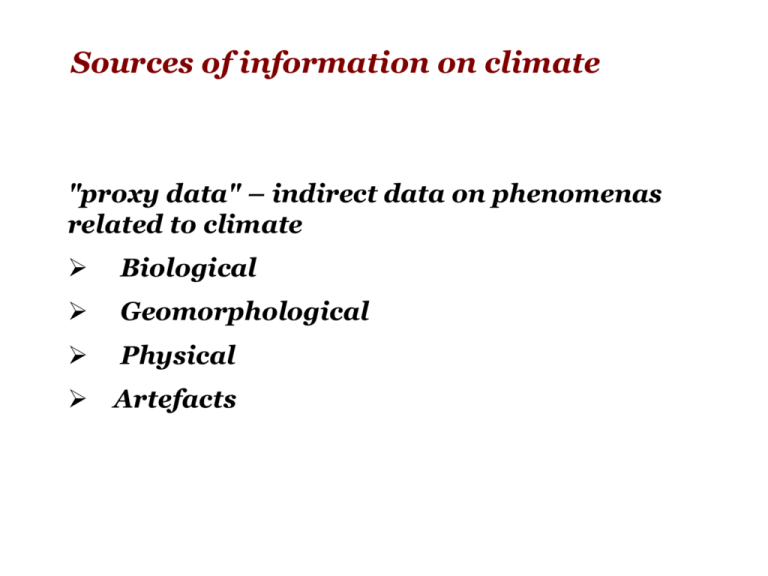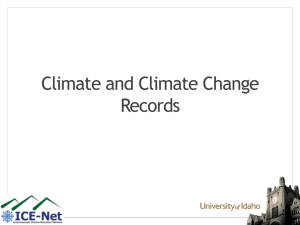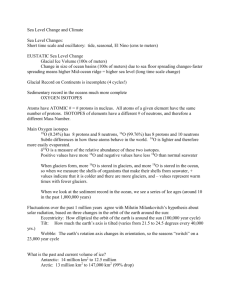Zmiany klimatu
advertisement

Sources of information on climate "proxy data" – indirect data on phenomenas related to climate Biological Geomorphological Physical Artefacts Physical.... Isotopes Atomic nucleus occupies only tiny part of the whole atom. Nucleus consists on nucleons: protons – with a positive electric charge, and neutrons – electrically neutral. The electric charges of proton and electron are equall. The mass of nucleons is about 2000 times bigger than mass of electron, the mass of proton is slightly bigger than the mass of proton (neutron = proton + electron) Atoms with the same number of protons, but differ with the number of neutrons are called isotopes Atomic number of element represents the number of protons in its nucleus. Mass number of element represents the number of nucleons (protons and neutrons) in its nucleus. Mass number Atomic number 37 17 Cl Element symbol Isotope measurements Some elements can have several stable isotopes – different types of atoms with different numbers of neutrons. (Number of protons in the nucleus define the element, number of neutrons define the isotope). The more neutrons in the nuclues the haviers the atmos. There are three stable isotopes of hydrogen, they are called: hydrogen(H), deuterium (D) i tritium (T). H H 1 1 T H D H 3 1 2 1 Here are also two stable isotopes of oxygen: O O 16 16 8 O O 18 18 8 The particle of water consists of two atoms of hydrogen and one atom of oxygen. In relation of their isotopes three different water particles can be found: H218O, H216O and HD16O Standard Mean Ocean Water (SMOW) consists in 99,76% of H216O, in 0,2% of H218O and in 0,03% of HD16O. HD16O / H 2 16Osample D 1000 16 1 16 HD O / H 2 OSMOW 18 16 H O / H 2 2 Osample 18 O 1000 18 1 16 H 2 O / H 2 OSMOW The snow falling of Greenland glaciers has 18O in the range 23 -38‰. The snow falling of Antarctic glaciers has 18O in the range -18 -60‰. In the case of HDO: D 8 O 10 / 00 18 0 Ratio 18O/16O Isotope 16O is lighter and evaporates faster than 18O. In normal conditions it returns to ocean together with precipitation. In glacial times 16O is trapped in the ice and a relative increase of 18O is observed in oceans. In warm periods, ice melts and the percentage of 16O increases. How can we use oxygen isotopes to tell air temperature in the distant past? In high latitude climates the 18O concentration in precipitation varies linearly with mean annual temperature. Assuming this relationship holds for the distant past, the 18O record in ice cores can therefore be used as a proxy for mean annual temperature at the time of precipitation of the snow on the glacier. During evaporation, the vapor, and hence clouds and precipitation, are poorer in 18O water than the rest of the water left behind. Precipitation preferentially removes more 18O, so later precipitation is still poorer in 18O. The tops of icecaps, which are cold and at high elevation, receive the most 18O-poor water as precipitation. 18O in ice therefore records air temperature. In contrast, the oceans accumulate excess 18O as 18O-poor water is transferred to the ice sheets. The more ice, the richer the water becomes in 18O. Foraminifera and other organisms growing from the water also become richer in 18O, so their skeletons in ocean sediment record the 18O concentration in sea water and so, indirectly, record ice volume. Ice and ocean sediment records are therefore complementary, each supplying different information about ice and ice formation. Volcanic eruptions leave dust and acids on the surface of glaciers. High winds over dry land blow dust onto glaciers. High winds over open ocean water produces lots of sea salt spray that can also become incorporated into glacial ice. The snow and ice itself contain oxygen and hydrogen isotopes, and bubbles of trapped air. All these can be analyzed to get an idea of what is going on around the mass of glacial ice. Ice cores Ice cores What we know about greenhouse gases Climatic records in ice cores History of Earth climate can be reconstructed on the basis of analysis of ice cores on Greenland and Anctarctic. • Temperatures from measurements of oxygen isotopes. • Greenhouse gases in air bubbles trapped in ice cores. 121 m deep, about 800 yrs Project participants: Norway, The Netherlands, Sweden, Finland, Estonia Austfonna drilled in 1998 and 1999 289 m deep, about 800 yrs Project participants: Japan, Norway Holtedahlfonna (Snøfjellafonna) drilled in April 2005 125 m deep, about 400 yrs Project participants: Norway, The Netherlands, Sweden, Finland, Estonia Ice cores and climate Elisabeth Isaksson Dmitry Divine Svalbard drill sites Lomonosovfonna drilled in April 1997 Methods of Dating Ice Cores • • • • • Stratigraphy Annual layers Ratio of 18O / 16O Electrical conductivity methods Using volcanic eruptions as Markers – Marker: volcanic ash and chemicals washed out of the atmosphere by precipitation – use recorded volcanic eruptions to calibrate age of the ice-core – must know date of the eruption Examples from Svalbard ice cores Volcanic eruptions Nuclear weapon tests 5 40 Laki 1783 30 3 20 2 10 1 Lomonosovfonna 2000 SO42- (eqvL-1) NO3- (eqvL-1) 4 137Cs (mBq/kg) 60 3H (Bq/kg) 25 1963 137 Cs Tritium(Bq/kg) 20 15 40 10 0 1770 1780 1790 Year (AD) 0 1800 20 5 0 0 10 20 Depth (m ) Kekonen and others, 2002 Pinglot and others, 2003 0 30 Ice cores and climate Elisabeth Isaksson Dmitry Divine Using specific events for dating ice cores Ice cores have layer thinning due to pure shear which means that if sample size is consistant the number per time unit will decrease with depth Ice cores and climate Elisabeth Isaksson Dmitry Divine Depth –age relationship Oldest ever ice cores origin from Antarctica Last Glacial Maximum CO2 (ppm) Antarctica 370 320 270 220 170 600000 400000 200000 czas (lata BP) 31 30 29 28 27 26 025 SST (°C) Tropical Pacific CO2 concentration and temperature 20 31 0 30 -20 29 -40 28 -60 -80 27 -100 26 -120 25 450 400 350 300 250 200 150 100 50 0 time (thousand years BP) SST (°C) Tropical Pacific Sea Level (m) Sea level during last 450 000 years shadow.eas.gatech.edu/~kcobb/isochem/lectures/lecture8.ppt Water isotopes in deep-sea cores growing glaciers deep-sea foraminifera The “Ice Volume” effectLight isotope removed from ocean, locked into large ice sheets. Ocean d18O shift (+1.5‰) recorded in marine carbonates that grew during glacial. SPECMAP – standard benthic d18O record, used to date marine sediments of unknown age shadow.eas.gatech.edu/~kcobb/isochem/lectures/lecture8.ppt Coral records of paleo-precipitation Theory: 1) more rain = lighter d18O “amount” effect 2) surface seawater d18O will become lighter 3) coral d18O lighter Cole and Fairbanks, 1990 shadow.eas.gatech.edu/~kcobb/isochem/lectures/lecture8.ppt Water isotopes in speleothems (cave stalagmites) Theory: 1) δ18O of speleothem = δ18O of precipitation 2) δ8O of precipitation function of temperature (mid- to high-latitudes) and/or amount of rainfall (low latitudes) Wang et al., Science , 2001 After: Reconstructing & simulating past climate variability., J.F. Gonzales Rouco After: Reconstructing & simulating past climate variability., J.F. Gonzales Rouco Borehole temperature profiles in central Greenland Historical data notes about harvest, corn prices blooming dates (cheeries from Japan more than 1000 years) sailing conditions (ice bergs aroud Iceland) dates of lakes freezing(Japan) notes about weather in old church cronicles (calendars) cave paintings characteristic features of houses weather descriptions HISTORICAL DOCUMENTS Corn prices C. Pfister, R. Brazdil (2006) Brazdil i in., 2005 On the wall of this house in Wertheim, Germany, there are marks of 24 high water events at riversTauber and Ren Pfister Pfister Weather diary, Jan from Kunowice, 1538, Czech Republic From the diary of Marcin Biem Potential sources of information about temperature before 1800 Jones, Osborn and Briffa (2001) Science Potential sources of information about humidity before 1800 Archive Instrumental Historical Tree rings measurements element Direct T, P, SLP Records/diaries etc. T, P, storms Widths T, P Density T Isotopes T, P Ice cores Accumulation Melt layers Isotopes Chemical composition Corals Growth SST, Salinity Isotopes SST, Salinity Chemical composition SST, Salinity caves Accumulation P Isotopes T, P Varves in lakes Varves in the ocean P T T, P Circulation Accumulation T Biological composition/pollen T, P Accumulation P Biological/chemical cmposition T, P Źródła wiedzy o klimacie i środowisku Dane instrumentalne Dane historyczne Dane pośrednie Dane pośrednie rzadko niosą informację o jednym tylko elemencie pogody (klimatu). Odczytanie informacji wymaga datowania i kalibracji Cape Spear Mariners’ logs, recording dates and positions of iceberg sightings pierścienie przyrostów drzew proporcje izotopów tlenu 18O/16O w wapiennych muszlach mikroorganizmów oceanicznych skład powietrza uwięzionego w lodzie grenlandzkim i antarktycznym zasięgi gatunków o wyraźnych preferencjach klimatycznych Western Brook Pond, Gros Morne Hearts Delight Okres połowicznego rozpadu rozpad beta W wyniku rozpadu beta otrzymujemy pierwiastek o wyższej liczbie atomowej rozpad alfa U Th He 238 92 234 90 4 2 w wyniku rozpadu alfa otrzymujemy pierwiastek o niższej liczbie atomowej Fluktuacje długości Grosser Aletsch w Alpach Szwajcarskich w ciągu ostatnich 2000 lat. Brazdil i in. 2005 Datowanie za pomocą węgla C-14 powstawanie węgla C-14 w przyrodzie bombardowanie atmosfery przez promieniowanie kosmiczne Węgiel C-14 ulega rozpadowi beta okres połowicznego rozpadu węgla wynosi 5730 lat Źródła wiedzy o klimacie w przeszłości "proxy data" – dane pośrednie o czynnikach zależnych od panujących warunków klimatycznych: pierścienie przyrostów drzew proporcje izotopów tlenu 18O/16O w wapiennych muszlach mikroorganizmów oceanicznych skład powietrza uwięzionego w lodzie grenlandzkim i antarktycznym zasięgi gatunków o wyraźnych preferencjach klimatycznych







